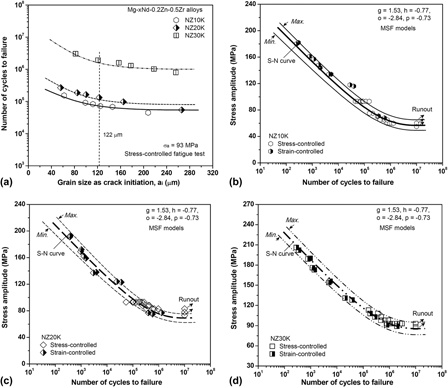Article contents
Effect of Nd additions on fatigue characteristics of a cast Mg–Zn–Zr alloy
Published online by Cambridge University Press: 09 February 2017
Abstract

The push–pull fatigue characteristics of the peak-aged Mg–0.2Zn–0.5Zr alloys with different addition levels of neodymium (Nd) have been investigated. The fatigue strength (σf) of the Mg–xNd–0.2Zn–0.5Zr (NZx0K) alloy increases proportionally with the increase of the Nd content (C Nd) as follows: σf (T6) ≈ (13.8–14.0) C Nd + 46 (for x between 0 and 3.0 wt%). The cyclic stress amplitude also increases but the plastic strain value decreases with the increase of the Nd content. The studied alloys exhibit the strain hardening followed by cyclic softening during fatigue test. During the low-cycle fatigue (LCF) test, the cracks originate from the cyclic deformation and cumulative damage. In high-cycle fatigue (HCF), the failure is due to the cyclic deformation and damage irreversibly caused by environment-assisted cyclic slip. The LCF lives of the alloys fitted well with the Coffin–Manson relation and Basquin laws, the three-parameter equation, and the energy-based concepts. The developed multi-scale fatigue (MSF) life models can be used to predict the LCF and HCF lives of the alloys. Among these models, the MSF life can well capture the influence of Nd addition on fatigue.
- Type
- Articles
- Information
- Copyright
- Copyright © Materials Research Society 2017
Footnotes
Contributing Editor: Jürgen Eckert
References
REFERENCES
- 2
- Cited by



